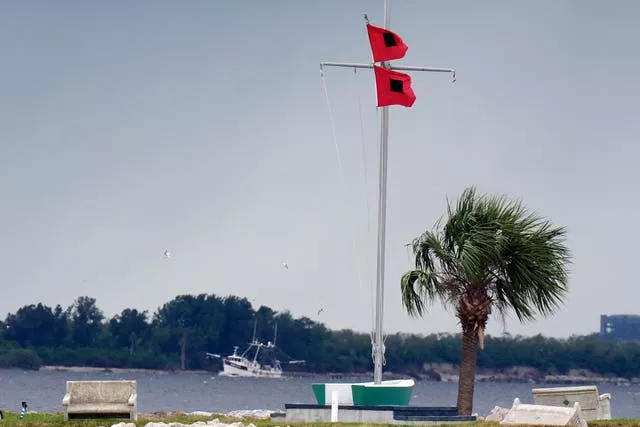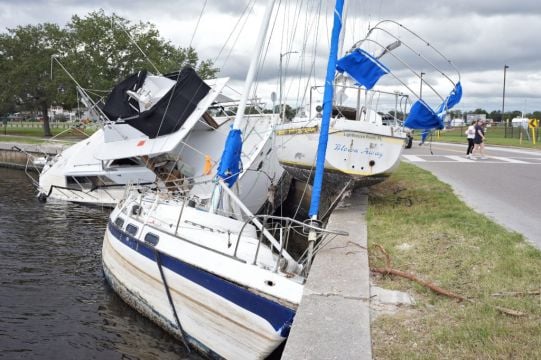Florida’s Gulf Coast braced on Tuesday for the impact of Hurricane Milton’s near-record winds and expected massive storm surge, which could bring destruction to areas already reeling from Helene’s devastation 12 days ago and still recovering from Ian’s wrath two years ago.
Almost the entirety of Florida’s west coast was under a hurricane warning early on Tuesday as the Category 5 storm and its 165mph (265kph) winds crept toward the state at 9mph (14kph), sucking energy from the Gulf of Mexico’s warm water.
The strongest Atlantic hurricane on record is 1980’s Allen, which reached wind speeds of 190 mph (306 kph) as it moved through the Caribbean and Gulf before striking Texas and Mexico.
Milton’s centre could come ashore on Wednesday in the Tampa Bay region, which has not endured a direct hit by a major hurricane in more than a century.
Scientists expect the system to weaken slightly before landfall, though it could retain hurricane strength as it churns across central Florida toward the Atlantic Ocean.
That would largely spare other states ravaged by Helene, which killed at least 230 people on its path from Florida to the Appalachian Mountains.
Tampa Bay has not been hit directly by a major hurricane since 1921, and authorities fear luck is about to run out for the region and its 3.3 million residents.
Hurricane #Milton is expected to grow in size and remain an extremely dangerous hurricane when it approaches the west coast of Florida on Wednesday. A large area of destructive storm surge will occur along parts of the west coast of Florida on Wednesday. This is an extremely… pic.twitter.com/1nNQYaJc9p
— National Weather Service (@NWS) October 8, 2024
Advertisement
President Joe Biden approved an emergency declaration for Florida, and US representative Kathy Castor said 7,000 federal workers were mobilised to help in one of the largest mobilisations of federal personnel in history.
“This is the real deal here with Milton,” Tampa mayor Jane Castor told a Monday news conference. “If you want to take on Mother Nature, she wins 100% of the time.”
The Tampa Bay area is still rebounding from Helene and its powerful surge — a wall of water up to 8 feet (2.4 meters) it created even though its eye was 100 miles (160 kilometres) offshore.
Twelve people died there, with the worst damage along a string of barrier islands from St Petersburg to Clearwater.
Forecasters warned that Milton could bring a possible eight- to 12-foot (2.4- to 3.6-metre) storm surge, leading to evacuation orders being issued for beach communities all along the Gulf coast.
In Florida, that means anyone who stays is on their own and first responders are not expected to risk their lives to rescue them at the height of the storm.
Stragglers were a problem during Helene and 2022’s Ian. Many residents failed to heed ample warnings, saying they evacuated during previous storms only to have major surges not materialise. But there was evidence on Monday that people were getting out before Milton arrives.
A steady stream of vehicles headed north towards the Florida Panhandle on Interstate 75, the main highway on the west side of the peninsula, as residents heeded evacuation orders.
Traffic clogged the southbound lanes of the highway for miles as other residents headed for the relative safety of Fort Lauderdale and Miami on the other side of the state.

About 150 miles (240 kilometres) south of Tampa, Fort Myers Beach was nearly a ghost town by Monday afternoon as an evacuation order took effect.
Ian devastated the 5,000-resident community two years ago, its 15-foot (4.5-metre) storm surge destroying or severely damaging 400 homes and businesses. Fourteen people died there as they tried to ride out the storm, and dozens had to be rescued.
On Monday, the few residents who could be found were racing against the clock to safeguard their buildings and belongings. None said they were staying.
The signs of Ian’s devastation remain visible everywhere. Rebuilt homes stand next to others in various states of construction. There are numerous vacant lots, which were once rare.
“This whole street used to be filled out with houses,” said Mike Sandell, owner of Pool-Rific Services. His workers were removing and storing pumps and heaters on Monday from his clients’ pools so they would not get destroyed.
Home construction supplies like bricks, piping and even workers’ outhouses lined the streets, potential projectiles that could do further damage if a surge hits.







